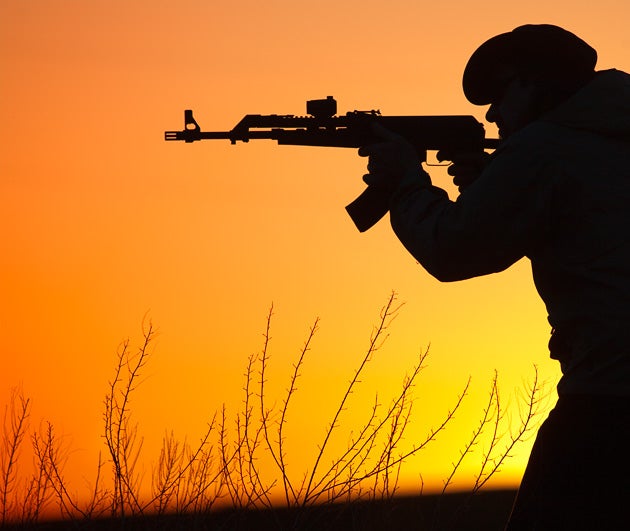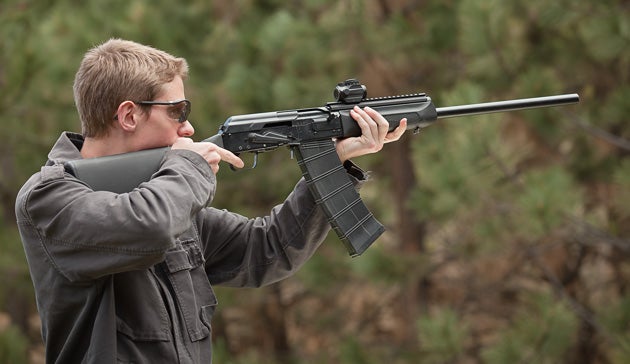Updating Old Guns to Accept Optics
Oleg Volk 05.19.14

Have you ever wondered why AK-47 sights are marked to 1,000 meters? The rifles themselves are 3-4MOA weapons at best, and the short sight radius limits effective aimed fire to a rather short range. The explanation is simple enough: AK-47 and its derivatives were never intended as “one shot, one hit” rifles, but rather as a cross between a submachine gun and a light machine gun. Notch and post sights work great for tracking motion up close as they don’t obscure the target much. The machine gun role, for which neither AK-47 nor the RPK light machine gun derived from it were ideal, presupposes creation of beaten zones. A slightly trained Soviet or Third World soldier wasn’t expected to make a precise and rapid shot against a barely visible foe, but he could be counted to rip off a short burst in the correct direction and possibly hit something within a meter or two of the point of aim. This is why the range adjustments make sense. They aren’t for hitting the target outright, but rather to make sure the shots land within some reasonable proximity of the enemy. If the bullets don’t produce a casualty, they would at least allow allied troops to maneuver and close in relatively safely.
American gun owners, as you may have noticed, do not have automatic fire capability on their AK variants. They also seldom maneuver by fire because they do not operate in large groups against either deer or muggers. The value is placed on the accuracy of every shot, and to that end better 7.62×39, 5.56×45 and 5.45×39 ammunition and barrels have been made. American AKs often have better triggers. While peep sights have replaced the rear notch sights on some rifles, more and more shooters have gone to optics.
The original optic mount for most Russian designed arms attaches to the side. It works fairly well but raises the optic high above the bore line, which both complicates the trajectory calculation and makes any cant result in significant horizontal deflection. It also requires a higher comb or cheek piece, making the iron sights unusable. One alternative is the railed receiver cover. (TWS makes one that works well.) Most other attempts to create such a design failed with the mount wobbling too much. The advantage of TWS approach is the ability to mount either a red dot sight or a magnified scope.
An AK-47 fitted with 2.5x scope is a far more effective weapon than the same rifle with only iron sights. Note that this scope was originally intended for an AR-15 and a lower mount would have been ideal. But the cheek piece is quickly removable, so returning to iron sights if necessary is a matter of seconds. On a flatter-shooting AK-74, optics are even more of a game-changer. Even seeing a 400 yard target with unaided eye is a challenge!
TWS makes such railed covers for most AK variants, Saigas, Veprs, and also for PSL 7.62×54. My own Vepr .308 uses their railed top cover and forend.
The other mounting solution, the railed hand guard, dates back to the 1990s. Originally designed for AK-47 clones, Ultimak rails have since been made for a wide variety of rifles and shotguns. The image above shows Aimpoint micro. In the photo below, a more economical Primary Arms red dot with an extra low mount allows a more full co-witnessing. The rail doesn’t change the weight of the rifle, and the 4.5oz of the sight barely affects the balance.
5.45 and .223 AK rifles extend point blank range significantly, so even red dots without rangefinding reticles are adequate for reliable 300 yard hits on torso-sized targets. 3MOA barrels are entirely adequate for that once the errors caused by the crude iron sights have been filtered out.
For some reason, Saiga shotguns come with very crude sights, with the radius only as long as the forend. They are sub-optimal for shot and completely inadequate for slug. Again, a red dot on a rail adds both speed and accuracy.
While M1 carbine sights aren’t quite as crude, this gun also gains from the addition of optics. In this case, the (discontinued) 2x magnified Aimpoint sight doesn’t add much speed but increases the precision of the little ugly to where it can be competently applied out to 250 yards.
The old Mini-14 standard model had no provision for optics at all. Mini-14 Ranch do, as do all the newer models, but even then the forward rail has its uses. It can be used for mounting offset light or laser, or a red dot mounted forward is a little faster to acquire. The configuration shown above — with a Leupold 2.5x fixed scout scope — yielded 2MOA slow fire with 55gr Winchester ball, a very respectable result.
Mini-14’s big brother the M1A can also be scoped with the big receiver mount. For high magnification optics, that’s the way to go. But for either a scout scope or a red dot sight, the forward mount works well. Retention of stripper clip feed is the additional benefit of the forward mounting, which may be of possible interest to Canadian and California shooters who are limited to five or ten round magazines.
Springfield makes SOCOM II, a 16″ .308 carbine with a prominent forward rail mount. The same Ultimak rail fits it as well, replacing the extensive quad with a more modestly sized alternative that’s half a pound lighter. A similar rail is available for M1 Garand.
In sum, an older rifle can be upgraded for optics use with minimal outlay of cash or gunsmithing. All of these rails can be installed by the user with just the basic tools. For many of us, the need for optics comes as the eyes age, for others as the budget allows for scopes, night vision, and other enhancements. The ability to see and engage further out is usually worth the extra few ounces of weight that the optics add.










